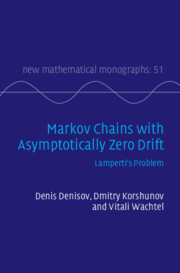Refine search
Actions for selected content:
3044 results in Probability theory and stochastic processes
2 - Lyapunov Functions and Classification of Markov Chains
-
- Book:
- Markov Chains with Asymptotically Zero Drift
- Published online:
- 24 April 2025
- Print publication:
- 08 May 2025, pp 41-87
-
- Chapter
- Export citation
Contents
-
- Book:
- Markov Chains with Asymptotically Zero Drift
- Published online:
- 24 April 2025
- Print publication:
- 08 May 2025, pp v-viii
-
- Chapter
- Export citation
5 - Limit Theorems for Transient Markov Chains with Drift Decreasing More Slowly Than 1/x
-
- Book:
- Markov Chains with Asymptotically Zero Drift
- Published online:
- 24 April 2025
- Print publication:
- 08 May 2025, pp 154-190
-
- Chapter
- Export citation
7 - Doob’s h-Transform: Transition from Recurrent to Transient Chain and Vice Versa
-
- Book:
- Markov Chains with Asymptotically Zero Drift
- Published online:
- 24 April 2025
- Print publication:
- 08 May 2025, pp 221-235
-
- Chapter
- Export citation
References
-
- Book:
- Markov Chains with Asymptotically Zero Drift
- Published online:
- 24 April 2025
- Print publication:
- 08 May 2025, pp 400-407
-
- Chapter
- Export citation

Markov Chains with Asymptotically Zero Drift
- Lamperti's Problem
-
- Published online:
- 24 April 2025
- Print publication:
- 08 May 2025
7 - Spatial Dependent Sequences
-
- Book:
- Dependence Models via Hierarchical Structures
- Published online:
- 20 March 2025
- Print publication:
- 27 March 2025, pp 102-117
-
- Chapter
- Export citation
2 - Conjugate Models
-
- Book:
- Dependence Models via Hierarchical Structures
- Published online:
- 20 March 2025
- Print publication:
- 27 March 2025, pp 23-32
-
- Chapter
- Export citation
Preface
-
- Book:
- Dependence Models via Hierarchical Structures
- Published online:
- 20 March 2025
- Print publication:
- 27 March 2025, pp ix-xii
-
- Chapter
- Export citation
Acknowledgments
-
- Book:
- Dependence Models via Hierarchical Structures
- Published online:
- 20 March 2025
- Print publication:
- 27 March 2025, pp xiii-xiv
-
- Chapter
- Export citation
Dedication
-
- Book:
- Dependence Models via Hierarchical Structures
- Published online:
- 20 March 2025
- Print publication:
- 27 March 2025, pp v-vi
-
- Chapter
- Export citation
Index
-
- Book:
- Dependence Models via Hierarchical Structures
- Published online:
- 20 March 2025
- Print publication:
- 27 March 2025, pp 135-136
-
- Chapter
- Export citation
6 - Temporal Dependent Sequences
-
- Book:
- Dependence Models via Hierarchical Structures
- Published online:
- 20 March 2025
- Print publication:
- 27 March 2025, pp 84-101
-
- Chapter
- Export citation
5 - General Dependent Sequences
-
- Book:
- Dependence Models via Hierarchical Structures
- Published online:
- 20 March 2025
- Print publication:
- 27 March 2025, pp 70-83
-
- Chapter
- Export citation
Frontmatter
-
- Book:
- Dependence Models via Hierarchical Structures
- Published online:
- 20 March 2025
- Print publication:
- 27 March 2025, pp i-iv
-
- Chapter
- Export citation
4 - Markov Sequences
-
- Book:
- Dependence Models via Hierarchical Structures
- Published online:
- 20 March 2025
- Print publication:
- 27 March 2025, pp 51-69
-
- Chapter
- Export citation
Appendix - Data Sets
-
- Book:
- Dependence Models via Hierarchical Structures
- Published online:
- 20 March 2025
- Print publication:
- 27 March 2025, pp 125-131
-
- Chapter
- Export citation
3 - Exchangeable Sequences
-
- Book:
- Dependence Models via Hierarchical Structures
- Published online:
- 20 March 2025
- Print publication:
- 27 March 2025, pp 33-50
-
- Chapter
- Export citation
References
-
- Book:
- Dependence Models via Hierarchical Structures
- Published online:
- 20 March 2025
- Print publication:
- 27 March 2025, pp 132-134
-
- Chapter
- Export citation
Contents
-
- Book:
- Dependence Models via Hierarchical Structures
- Published online:
- 20 March 2025
- Print publication:
- 27 March 2025, pp vii-viii
-
- Chapter
- Export citation
